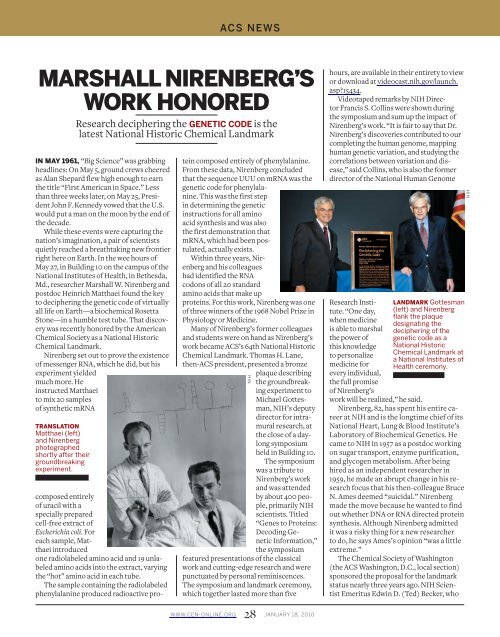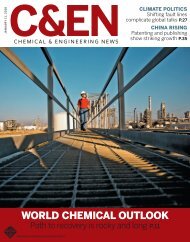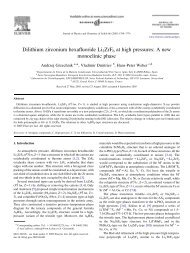Chemical & Engineering News Digital Edition - January 18, 2010
Chemical & Engineering News Digital Edition - January 18, 2010
Chemical & Engineering News Digital Edition - January 18, 2010
You also want an ePaper? Increase the reach of your titles
YUMPU automatically turns print PDFs into web optimized ePapers that Google loves.
IN MAY 1961, “Big Science” was grabbing<br />
headlines: On May 5, ground crews cheered<br />
as Alan Shepard flew high enough to earn<br />
the title “First American in Space.” Less<br />
than three weeks later, on May 25, President<br />
John F. Kennedy vowed that the U.S.<br />
would put a man on the moon by the end of<br />
the decade.<br />
While these events were capturing the<br />
nation’s imagination, a pair of scientists<br />
quietly reached a breathtaking new frontier<br />
right here on Earth. In the wee hours of<br />
May 27, in Building 10 on the campus of the<br />
National Institutes of Health, in Bethesda,<br />
Md., researcher Marshall W. Nirenberg and<br />
postdoc Heinrich Matthaei found the key<br />
to deciphering the genetic code of virtually<br />
all life on Earth—a biochemical Rosetta<br />
Stone—in a humble test tube. That discovery<br />
was recently honored by the American<br />
<strong>Chemical</strong> Society as a National Historic<br />
<strong>Chemical</strong> Landmark.<br />
Nirenberg set out to prove the existence<br />
of messenger RNA, which he did, but his<br />
experiment yielded<br />
much more. He<br />
instructed Matthaei<br />
to mix 20 samples<br />
of synthetic mRNA<br />
composed entirely<br />
of uracil with a<br />
specially prepared<br />
cell-free extract of<br />
Escherichia coli. For<br />
each sample, Matthaei<br />
introduced<br />
one radiolabeled amino acid and 19 unlabeled<br />
amino acids into the extract, varying<br />
the “hot” amino acid in each tube.<br />
The sample containing the radiolabeled<br />
phenylalanine produced radioactive pro-<br />
ACS NEWS<br />
MARSHALL NIRENBERG’S<br />
WORK HONORED<br />
Research deciphering the GENETIC CODE is the<br />
latest National Historic <strong>Chemical</strong> Landmark<br />
TRANSLATION<br />
Matthaei (left)<br />
and Nirenberg<br />
photographed<br />
shortly after their<br />
groundbreaking<br />
experiment.<br />
tein composed entirely of phenylalanine.<br />
From these data, Nirenberg concluded<br />
that the sequence UUU on mRNA was the<br />
genetic code for phenylalanine.<br />
This was the first step<br />
in determining the genetic<br />
instructions for all amino<br />
acid synthesis and was also<br />
the first demonstration that<br />
mRNA, which had been postulated,<br />
actually exists.<br />
Within three years, Nirenberg<br />
and his colleagues<br />
had identified the RNA<br />
codons of all 20 standard<br />
amino acids that make up<br />
proteins. For this work, Nirenberg was one<br />
of three winners of the 1968 Nobel Prize in<br />
Physiology or Medicine.<br />
Many of Nirenberg’s former colleagues<br />
and students were on hand as Nirenberg’s<br />
work became ACS’s 64th National Historic<br />
<strong>Chemical</strong> Landmark. Thomas H. Lane,<br />
then-ACS president, presented a bronze<br />
plaque describing<br />
the groundbreaking<br />
experiment to<br />
Michael Gottesman,<br />
NIH’s deputy<br />
director for intramural<br />
research, at<br />
the close of a daylong<br />
symposium<br />
held in Building 10.<br />
The symposium<br />
was a tribute to<br />
Nir enberg’s work<br />
and was attended<br />
by about 400 people,<br />
primarily NIH<br />
scientists. Titled<br />
“Genes to Proteins:<br />
Decoding Genetic<br />
Information,”<br />
the symposium<br />
featured presentations of the classical<br />
work and cutting-edge research and were<br />
punctuated by personal reminiscences.<br />
The symposium and landmark ceremony,<br />
which together lasted more than five<br />
WWW.CEN-ONLINE.ORG 28 JANUARY <strong>18</strong>, <strong>2010</strong><br />
NIH<br />
hours, are available in their entirety to view<br />
or download at videocast.nih.gov/launch.<br />
asp?15434.<br />
Videotaped remarks by NIH Director<br />
Francis S. Collins were shown during<br />
the symposium and sum up the impact of<br />
Nirenberg’s work. “It is fair to say that Dr.<br />
Nirenberg’s discoveries contributed to our<br />
completing the human genome, mapping<br />
human genetic variation, and studying the<br />
correlations between variation and disease,”<br />
said Collins, who is also the former<br />
director of the National Human Genome<br />
Research Institute.<br />
“One day,<br />
when medicine<br />
is able to marshal<br />
the power of<br />
this knowledge<br />
to personalize<br />
medicine for<br />
every individual,<br />
the full promise<br />
of Nirenberg’s<br />
work will be realized,” he said.<br />
LANDMARK Gottesman<br />
(left) and Nirenberg<br />
flank the plaque<br />
designating the<br />
deciphering of the<br />
genetic code as a<br />
National Historic<br />
<strong>Chemical</strong> Landmark at<br />
a National Institutes of<br />
Health ceremony.<br />
Nirenberg, 82, has spent his entire career<br />
at NIH and is the longtime chief of its<br />
National Heart, Lung & Blood Institute’s<br />
Laboratory of Biochemical Genetics. He<br />
came to NIH in 1957 as a postdoc working<br />
on sugar transport, enzyme purification,<br />
and glycogen metabolism. After being<br />
hired as an independent researcher in<br />
1959, he made an abrupt change in his research<br />
focus that his then-colleague Bruce<br />
N. Ames deemed “suicidal.” Nirenberg<br />
made the move because he wanted to find<br />
out whether DNA or RNA directed protein<br />
synthesis. Although Nirenberg admitted<br />
it was a risky thing for a new researcher<br />
to do, he says Ames’s opinion “was a little<br />
extreme.”<br />
The <strong>Chemical</strong> Society of Washington<br />
(the ACS Washington, D.C., local section)<br />
sponsored the proposal for the landmark<br />
status nearly three years ago. NIH Scientist<br />
Emeritus Edwin D. (Ted) Becker, who<br />
NIH




